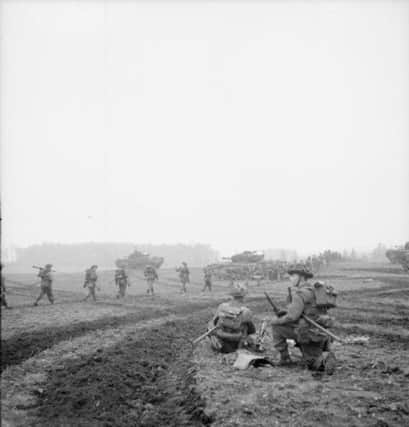Storming the trenches with bayonets fixed


She says Denys Hunter, of 342 Battery, gave the following details of the conflict, saying: “The war taught us self- reliance. You stopped caring about the death all around you. You became hardened to it. If you thought about it, you wouldn’t have been able to go on. See, we knew we were fighting to stop our nation becoming a slave nation of the Third Reich – we were fighting to preserve our way of life.”
Meanwhile, fellow soldier and battery driver Joe Cattini added: “The stand-tos in the Reichswald were nerve-wracking. At one point the battery had some billets in a German farmhouse. We slept in the pig sty! We cleaned it out and put some fresh straw in to make it warmer and then we had a stand-to all night so we couldn’t sleep because the Germans were dangerously near.”
Advertisement
Hide AdAdvertisement
Hide AdDuring the artillery’s rolling barrage, the infantry attacked.
As Dorothy explans, the 15th Scottish Infantry Division skirted the northern fringe of the Reichswald Forest and fought through horrendous conditions with very little tank support because of the boggy ground. Nevertheless they succeeded in capturing the towns of Frasselt and Kranenburg, only three miles from Cleve.
“There were no buildings for shelter. Living conditions were basic, and the constant enemy shelling wearing. The Germans fired propaganda leaflet shells with messages such as “Why should Englishmen be killing Germans when both should be fighting Bolshevism?”
“Predictably the British soldiers treated them with contempt and derision. Orders for concealment were implemented – new digging had to be concealed, camouflage nets had to be used on vehicles in non-built up areas and in built-up areas vehicles had to be parked close to buildings.
Advertisement
Hide AdAdvertisement
Hide Ad“Blackout precautions were implemented for petrol cookers and fires in unscreened places, and torches dimmed with meals eaten under cover. Cooking smells or a flash of light, even a cigarette ember or smell could give away a position.”
Dorothy goes on to explain that on the morning of February 9, the Sexton SP Guns of 86th Field Regt R.A. rumbled up to a position on the southern outskirts of Kranenburg.
“The 342 Battery had to abandon positions because of flooding and boggy conditions and went into action on the railway, which provided platforms that were not thigh deep in water.”
Joe Cattini reported: “When I was in the Reichswald Forest I picked up a discarded German parachutist coat which was lovely and warm and kept the cold out better than the leather jerkin supplied to us drivers and crew. See, only the gunners in the Sextons and those in Sherman tanks had been issued with winter zoot-suits.
Advertisement
Hide AdAdvertisement
Hide Ad“Plus there was no heater in the truck so I was glad to have mittens and pilot’s boots which I’d acquired.
Of course, they looked very durable all lined with sheepskin but really they were useless in the rain and snow because the soles were cardboard.
“I used to put my denim issue trousers on top of my khakis to keep warm.”
At this point the British were up against 4 Parachute, 3 Infantry and 2 Panzer Divisions. Many of the enemy soldiers refused to surrender.
British soldiers stormed the trench systems often at bayonet point, enemy snipers picked off soldiers from the tree tops.
l Monday: The troops make a harrowing discovery.